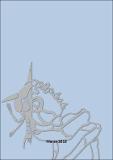Por favor, use este identificador para citar o enlazar a este item:
http://hdl.handle.net/10261/167376COMPARTIR / EXPORTAR:
 SHARE
BASE SHARE
BASE
|
|
| Visualizar otros formatos: MARC | Dublin Core | RDF | ORE | MODS | METS | DIDL | DATACITE | |

| Campo DC | Valor | Lengua/Idioma |
|---|---|---|
| dc.contributor.advisor | Guerao, Guillermo | - |
| dc.contributor.advisor | Rotllant, Guiomar | - |
| dc.contributor.author | Castejón, Diego | es_ES |
| dc.date.accessioned | 2018-07-05T07:30:42Z | - |
| dc.date.available | 2018-07-05T07:30:42Z | - |
| dc.date.issued | 2018 | - |
| dc.identifier.uri | http://hdl.handle.net/10261/167376 | - |
| dc.description | Memoria de tesis doctoral presentada por Diego Castejon Bueno para obtener el título de Doctor en Biodiversidad por la Universitat de Barcelona (UB), realizada bajo la dirección del Dr. Guillermo Guerao Serra y de la Dra Guiomar Rotllant Estelrich del Institut de Ciències del Mar (ICM-CSIC).-- 776 pages | es_ES |
| dc.description.abstract | The present Doctoral Thesis is framed in the research toward the profitable culture of the common spider crab (Maja brachydactyla Balss, 1922) focusing in two topics: the improvement of the larval culture and the description of the digestive system. Our results conclude that the optimal parameters were: 21 ± 1 °C, 35 ± 1 psu and a daily light-dark cycle. Temperature influences the duration of the larval development, salinity the survival and light have a poor influence. This species does not have special requirements for settlement. The basic morphology of the digestive system is conserved during all the life stages. The main differences rely on the higher development of connective and muscles in adult specimens comparing to larval stages. The biggest change occur in the stomach, since acquires cardiac sacs, ossicle system and gastric mill after the molt to megalopa. The caeca of the midgut gland (hepatopancreas) are very similar between larvae and adults, but their number increases from fourteen in the larvae to tens of thousands in the adults. The esophagus and hindgut tract are characterized by the presence of a cuticle with microspines and rosette glands in the connective. The midgut gland, midgut tract and midgut caeca are very rich in microvilli. The midgut gland realizes absorptive and secretory functions, the midgut tract secretes the peritrophic membrane and the midgut caeca realizes an important secretory activity. For first time, the "micro-apocrine" secretion is described in decapods | es_ES |
| dc.language.iso | spa | es_ES |
| dc.publisher | Universidad de Barcelona | es_ES |
| dc.publisher | CSIC - Instituto de Ciencias del Mar (ICM) | - |
| dc.rights | openAccess | es_ES |
| dc.title | Morfología del sistema digestivo y larvicultura del centollo (Maja brachydactyla, Balss 1922) | es_ES |
| dc.type | tesis doctoral | es_ES |
| dc.description.peerreviewed | Peer reviewed | es_ES |
| dc.relation.csic | Sí | es_ES |
| oprm.item.hasRevision | no ko 0 false | * |
| dc.type.coar | http://purl.org/coar/resource_type/c_db06 | es_ES |
| item.openairetype | tesis doctoral | - |
| item.grantfulltext | open | - |
| item.cerifentitytype | Publications | - |
| item.openairecristype | http://purl.org/coar/resource_type/c_18cf | - |
| item.fulltext | With Fulltext | - |
| item.languageiso639-1 | es | - |
| Aparece en las colecciones: | (ICM) Tesis | |
Ficheros en este ítem:
| Fichero | Descripción | Tamaño | Formato | |
|---|---|---|---|---|
| Castejon_Thesis_2018.pdf | 112,6 MB | Adobe PDF |  Visualizar/Abrir |
CORE Recommender
Page view(s)
307
checked on 19-abr-2024
Download(s)
81
checked on 19-abr-2024
Google ScholarTM
Check
NOTA: Los ítems de Digital.CSIC están protegidos por copyright, con todos los derechos reservados, a menos que se indique lo contrario.
